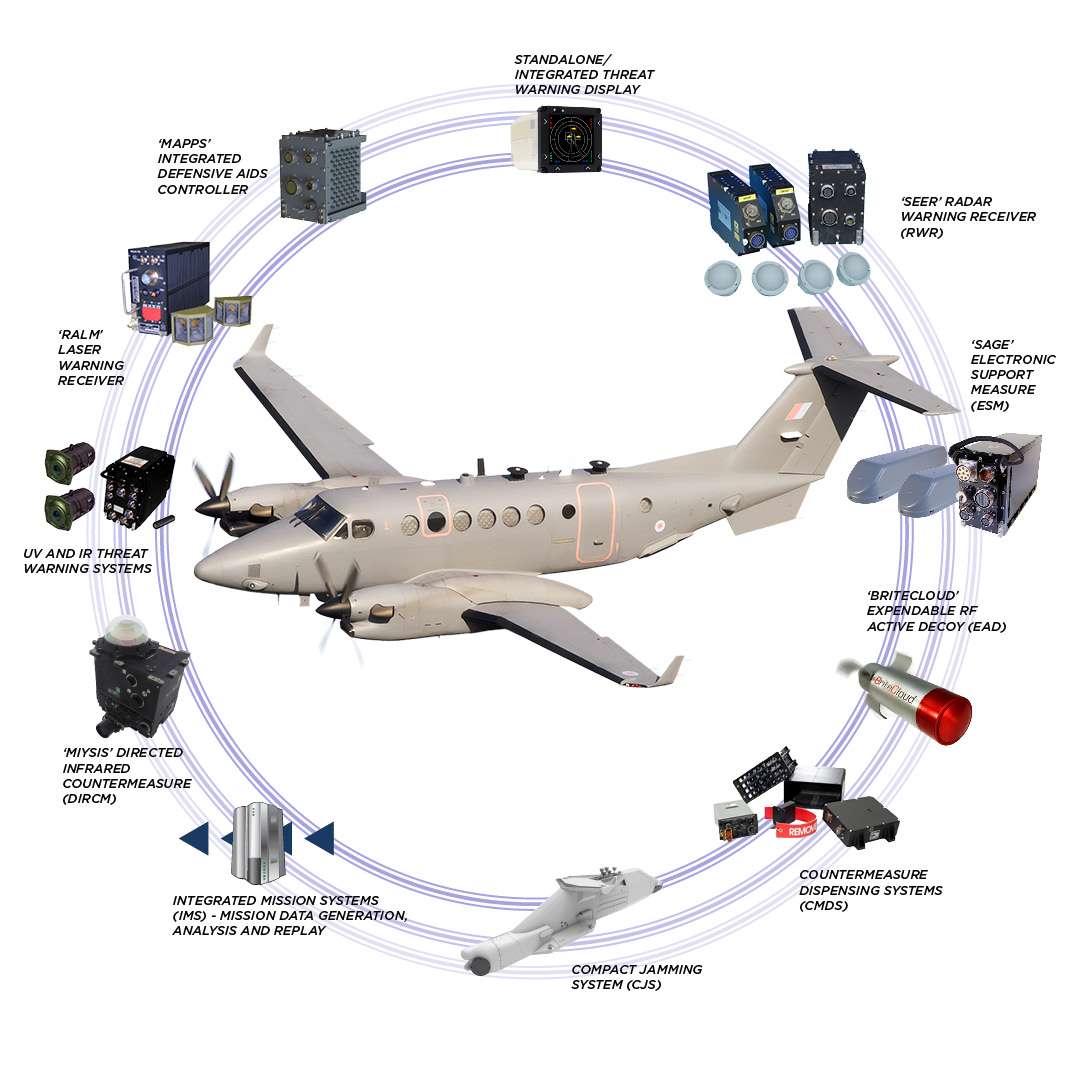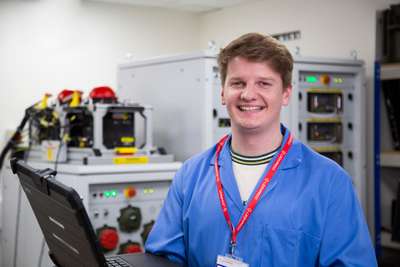Added: Over a year ago by Leonardo
Military conflicts over the past decade have seen changing operational theatres and threat environments facing armed forces. From agile insurgencies in Iraq and Afghanistan to the artillery-heavy warfare in Ukraine, each scenario presents different challenges for air superiority and survivability that technology and service personnel have had to rapidly adapt to. In this article, we look at how Leonardo is working with the UK Ministry of Defence and international allies to stay ahead of the threats.
Leonardo has gained a long pedigree, for more than 100 years, of producing Electronic Warfare capability and integrating Defensive Aids System (DAS) for UK military platforms. From its origins with Marconi and the development of gyros for Spitfires during WW2, through the Tornado Sky Shadow jamming pod, to the development of the Helicopter Integrated Defensive Aids System (HIDAS) for the Apache AH Mk1 and AW159 Wildcat helicopters, and the Praetorian DASS for Eurofighter Typhoon.
Over the past 10-15 years, the company has worked closely with Defence Science and Technology Laboratory (Dstl) and the Royal Air Force Rapid Capabilities Office (RCO) to develop this capability further and to address future threats, leading to the evolution of the Modular Advanced Platform Protection System (MAPPS) – a military avionics product which underpins Next Generation Air Survivability (NGAS) and exploits the NATO Defensive Aids System (NDAS) standard architecture.
“Historically, countermeasures have been based on a concept of federated systems that have not been particularly well integrated,” explains Leonardo Project Chief Engineer, Gareth Fear. “The legacy systems used by the UK for the past 15-20 years are now reaching the limits of their capabilities. While you can defeat fairly basic threats with a missile warner and flare, MAPPS will fuse data from multiple sensors, providing the aircrew with situational awareness and enhanced countermeasure capabilities.”
Leonardo Campaign Manager, Dion Martin, points to the evolving threat picture where the surface-to-air threat posed by well-dispersed and effective Integrated Air Defence Systems (IADS), along with the proliferation of more advanced Man-Portable Air Defence Systems (MANPADS), creates ever greater challenges. “There’s a real step change in the threat system that aircrews are likely to face over the coming years, so we have worked extensively under our Strategic Partnership Agreement (SPA) with the RAF, DE&S and Dstl to offer a sovereign UK solution. This will offer NGAS for current threats and evolve to address future systems, whatever they are likely to be,” he says.
“The blend of expertise provided by Leonardo’s workforce – combining technology specialists and customer-facing people who have worked in the aerospace sector for many years, with ex-service personnel who bring frontline experience and knowledge – means we understand the customer challenges at hand and we can develop the technology to address and solve them.”
At the heart of the MAPPS approach is the ability to update software modules as required to manage and counter against new and emerging threats. MAPPS protects aircrew against a variety of threat systems across the electromagnetic spectrum, prioritising the response with automated countermeasures. The MAPPS Controller is embedded in the system architecture, with responsibility for the critical decision-making necessary to preserve life. Its synchronised sensors and effectors deliver world-class protection against: surface to air missiles and air to air missiles; guided artillery such as anti-tank missiles; and unguided artillery such as rockets, rocket propelled grenades and small arms fire.

Looking further ahead, work under the MAPPS programme will also contribute to and benefit from other major air programmes including Typhoon and future combat air systems, according to Gareth.
“This is something that we need to look at as part of the continued development of MAPPS,” he says. “Our colleagues working as part of Team Tempest are developing capabilities required for the tri-national Global Combat Air Programme and we expect to see significant engagement between this and the MAPPS programme in future. Some of the lower level software that is used within the MAPPS Controller is packaged and common across Leonardo. This means we can utilise common software, where appropriate, across multiple programmes, creating synergies and ensuring interoperability. With the spiral development of technology and capability across projects, including the Typhoon’s Praetorian Defensive Aids Sub-System (DASS), we ensure that everything we produce is fit for the future battlespace.”

For those working at the cutting edge of technology, programmes such as MAPPS are “an exciting prospect”, according to Gareth. “This is highlighted by the variety of people working within the project team – from the likes of me who has over 12 years’ experience within the IDAS domain, all the way to those at the start of their careers.
“Typically, an IDAS project runs for 3-4 years, providing engineers with experience in all stages of the engineering lifecycle, ranging from early Concept of Operations (CONOPS) work with the end-user through to formal certification and release to service. This also opens up opportunities to specialise in certain areas.”
While graduates and apprentices get to grips with working in a completely new environment, Dion adds that they provide fresh insights and real value to MAPPS. “The continued development of the technology is driven by our people. The younger generation of engineers, scientists and strategists are the ones who will continue to develop this new technology. This extends beyond MAPPS, into the other programmes, and gives people the opportunity to grow their skillsets.”
One such example is Angus Buckman, who completed his graduate programme with Leonardo in 2021 and is now a Senior Systems Engineer. His involvement with MAPPS has opened up wider exposure to programmes since joining the company. “Because the MAPPS Controller provides flexibility for solutions across multiple programmes, I have had the opportunity to work between some of these, operating with sensor and effector system suppliers to successfully integrate their technology with the MAPPS Controller,” he explains.
“This has been both challenging and very rewarding. Having had the chance to extend my domain knowledge significantly through working collaboratively with subject matter experts, MAPPS has provided me with the tools and skills to progress as an engineer.”
NATO’s assessment of current and future threats is that air superiority is no longer a given with aircrew or uncrewed assets operating in higher threat environments. Therefore, MAPPS will play a critical role in maintaining air survivability and achieving enhanced protection against complex and evolving EW threat systems.
Successfully achieving this will be down to MAPPS’s modularity, and the ability to incrementally update software to manage and counter new and emerging threats.
“The MAPPS Controller has hooks for future capabilities such as hosting third party applications and collaborative countermeasures, which is a key future functionality to support air platform protection,” adds Gareth. “Through a future technology roadmap, Leonardo and MOD are working collaboratively to develop these capabilities using the spiral model of risk-driven software development, enabling the technology to evolve with the threat, analysing the types of threat facing each platform and working out what capability is needed to defeat each one.”
“As the threat picture changes, the complexity of future operations increases and we are faced with ever greater challenges, MAPPS will continue to evolve,” concludes Dion. “What we have, is a system that can deliver NGAS for the present and maintain an over-matching level of capability in coming years.”